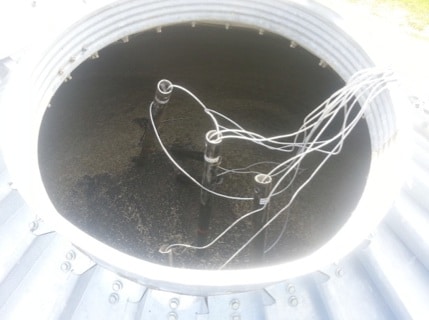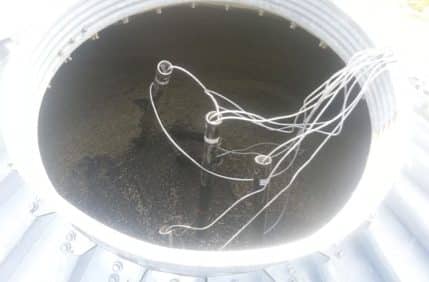
PAMI, with funding from the provincial canola growers organizations, is running a storage project this summer to test the best management practice for canola bins as they move from winter to spring to summer. Should they be turned to warm them up? Aerated to warm them up? Or left alone so they stay cold for as long as possible?
The three treatments are:
Bin #20: 4000 bu, Chief Westland, 18 ft diameter (Grain was “turned” at beginning of trial in early June.)
Bin #21: 4000 bu, Sakundiak, 18 ft diameter (No treatment)
Bin #22: 2800 bu, Westeel Rosco, 19 ft diameter (Aeration fans turned on at night. This will start soon.)
Observations as of mid June:
—The core temperature in the turned bin has been slowly declining since it was turned. When a portion of the grain is removed, the grain from the top funnels down through the core of the bin. The grain between the core and the edge of the bin remains relatively unmoved. So, after pulling out 700 bushels, the core of bin 20 was warm (see attached graphic showing the temperature distribution in bin 20 within 2 hours of turning) because this grain was near the top of the bin before turning. The grain at the edges is also warm due to it being near the wall. But the grain between the core and the edge was still cool (approximately -20°C, data not logged). Therefore, the grain in the core is slowly equilibrating to the temperature of the colder grain next to it.
—The grain at the edge of bin 20 is theoretically also equilibrating to the temperature of the colder grain next to it, but it is also equilibrating to the ambient temperature on the other side of it. So the temperature at the edge of the bin has remained relatively stable.
—The grain in the centre of bin 20 has stabilized at approximately -1°C. This is much warmer than the temperatures in the center of bin 21, which has the same amount of grain and started at the same temperature. Therefore, turning the grain in bin 20 did help to minimize the temperature variations in the bin. HOWEVER…the grain in the center of bin 20 is closer to saturation (100% relative humidity) than the grain in the center of bin 21. That’s because the warm air that funneled through the core during turning was holding a certain amount of water. Now that the air has cooled, its capacity to hold water has decreased so its relative humidity has increased. Based on the conditions in the center of bin 20 two hours after it was turned, it would have to cool to -5°C before reaching dewpoint. [Assuming the moisture doesn’t migrate…which it does…more on that in the next update!]
—The temperature in the headspace can fluctuate up to 40°C in a 24 hour period. The peak headspace temperature we have seen is 52°C! Fortunately, the RH of the headspace is usually very low.
*Thanks to Joy Agnew, PAMI’s research lead on the bin project, for providing this update. See regular updates here.
